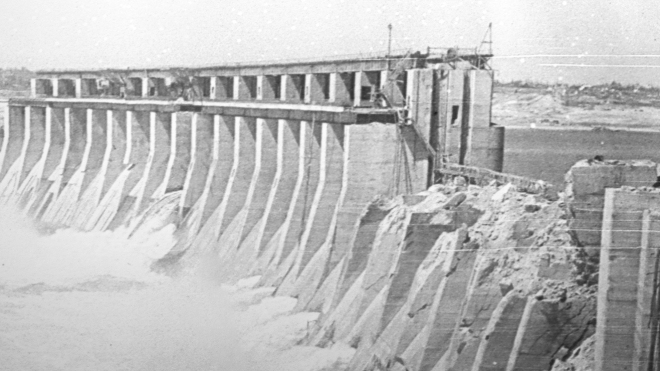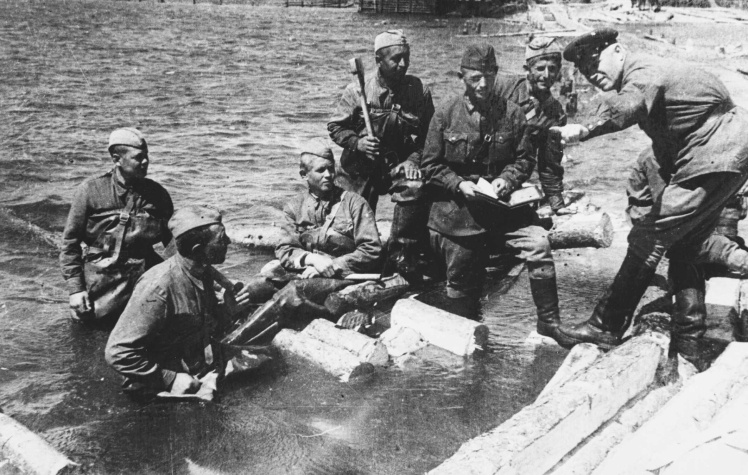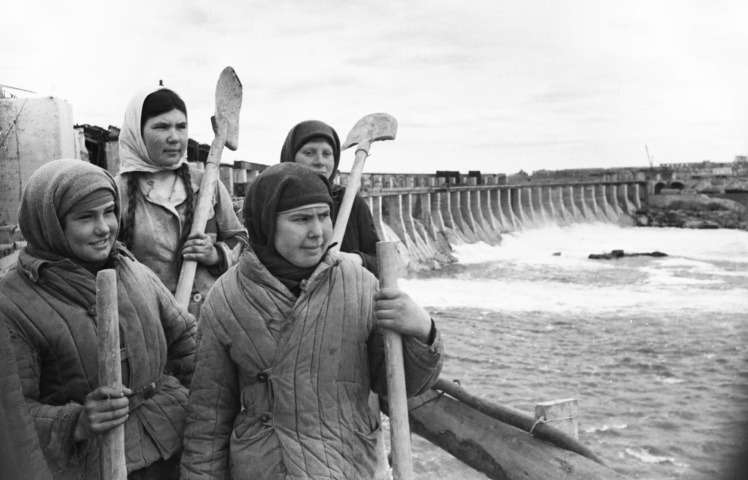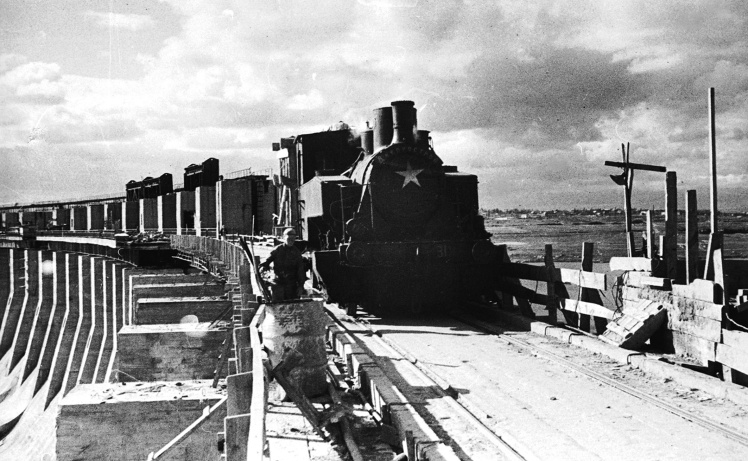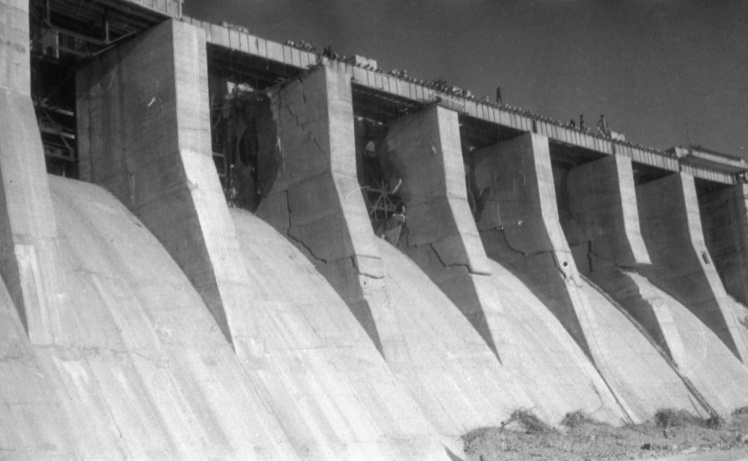It was decided to build a hydroelectric power plant (HPP) in Zaporizhzhia in the early 1920s as part of a large-scale plan for electrification of the country. The plant was built using American technologies, specialists from the USA came to Zaporizhzhia for consultations. The Bolsheviks generously paid them with jewelry and works of art. But the most popular commodity was grain, which was taken from the peasants even during the famine in the 1920s and the Holodomor in Ukraine in the early 1930s.
The Dnipro HPP was declared an all-Union construction project, where, in addition to the "fighters of the construction army", the unpaid and unprotected labor of prisoners was used. In 1927, a bridge was laid, and in 1932, the first unit of the new power plant was put into work. In 1939, the Dnipro HPP became the largest power plant in Europe and the third largest in the world.
General view of the Dnipro HPP dam, Zaporizhzhia, before 1941.
Two years after the start of the WWII, Germany attacked its former ally, the USSR. Soviet troops had withdraw with heavy losses. And the Germans broke through to Kyiv and large industrial and port centers — Zaporizhzhia, Mykolaiv, Kherson, Odesa, Ochakiv. By the middle of August 1941, the forces of the German army group "South" reached Dnipro River along the entire line from Kherson to Kyiv. According to the memories of the Chief of the General Staff of the German Land Forces Franz Halder, on August 17-18, 1941, one of the German tank divisions was already almost a kilometer away from the Dnipro HPP dam.
A German tank crushed by a tank of Soviet captain Kokushkin on the approaches to the Dnipro River, August 1941.
On the evening of August 18, Soviet units were restraining the offensive and covering the withdrawing of other units, when at approximately 20:15 a powerful explosion rang out, and a wave about 100 meters long and 30 meters high rushed from the side of the Dnipro HPP dam. "Military vehicles and people who were moving along the dam at that time, of course, died. An almost thirty-meter avalanche of water swept through the Dnipro floodplain, washing away everything in its path. The entire lower part of Zaporizhzhia with huge stocks of various goods, military materials, tens of thousands of tons of food products, etc. was washed away in a matter of minutes. Dozens of ships, along with their crews, perished in that terrible current. [Soviet] military units were in positions in the Dnipro floodplains tens of kilometers to Nikopol and beyond. A huge stream came unexpectedly. A large number of Red Army soldiers and officers with artillery and military equipment were killed. In addition to the military, tens of thousands of cattle and many people who were at work died in the floods," the eyewitness Fedir Pihido-Pravoberezhny described those events.
The dam of the Dnipro HPP after being blown up by NKVD officers, August 1941.
Wikimedia
The Dnipro HPP was mined as early as August 1941. For this, more than 20 tons of explosives were brought by plane from Moscow. Engineer-Colonel Boris Epov and Lieutenant-Colonel Aleksei Petrovskiy were responsible for the operation. But it is still not known exactly who determined the time of "extreme necessity" for detonation. Some historians believe that the order was given by the commander of the troops of the southwestern direction Semyon Budyonnyi, the others think that Stalin personally sent the code from Moscow, and the others think that the employees of the 157th regiment of the NKVD, who were supposed to set off the explosives, panicked prematurely. This came as a surprise even to the high command. "We were in Zaporizhzhia when suddenly the ground shook under our feet — the air shuddered from an explosion of enormous force," the commander of the Southern Front Ivan Tyuleniev recalled.
At first, the Soviet leadership tried to blame everything on "enemy saboteurs", but this version had to be abandoned. On August 21, 1941, the American newspaper The New York Times published an article about the detonation of the Dnipro HPP dam by the "withdrawing Russians" on first page. It contained a comment by a diplomat from one of the countries of Hitlerʼs coalition, who compared such actions to a "scorpion that stung itself".
The detonation of the dam did not cause serious damage to the German troops. After the explosion of the Dnipro HPP, the defense of Zaporizhzhia lasted for another month and a half. During this time, almost all the equipment of large factories managed to be taken out of the city. As for the casualties among Soviet soldiers and civilians, there are no exact data. They are estimated by approximate numbers from 20 to 100 thousand people. In addition, several thousand Red Army soldiers who evacuated to the left bank of the Dnipro downstream were cut off by water and had to surrender.
German soldiers force the Dnipro, September 10, 1941 A column of German motorized anti-aircraft guns in the Dnipro area, August 25, 1941 Soviet soldiers build a crossing over the river, summer of 1941.
Germans were really surprized by the way in which all of the stationʼs equipment was disabled. German Minister of Armaments Albert Speer admired this "find". "I also visited the blown-up power plant in Zaporizhzhia. During their witthdrawing, the Russians disabled the equipment in a rather simple and primitive way: by switching the lubrication distributor while the turbines were in full operation. Deprived of lubrication, the machines overheated and literally devoured themselves, turning into a pile of unusable scrap metal. It is a very effective means of destruction, and all it takes is a simple turn of the handle by one person."
If the destroyed part of the dam was restored quickly enough by German construction units, the new equipment had to be brought from Germany. In the summer of 1942, the power plant started working again.
The Dnipro HPP station after the restoring by Germans, summer of 1942.
Wikimedia
In 1943, the situation on the Eastern Front changed, the Soviet troops went on the offensive. Now the Germans have already started preparing to blow up the Dnipro HPP. Mining began in March 1943, more than half a year before the actual withdraw from Zaporizhzhia. About 200 tons of explosives and aerial bombs were supposed to completely destroy the station. But Soviet sappers and reconnaissance men managed to damage part of the wires that went to the detonators. Because of this, the Germans managed to blow up only part of the dam.
Soldiers of the 3rd Ukrainian Front near the Dnipro HPP dam after the liberation of Zaporizhzhia from German troops, October 1943.
But everything else had to be rebuilt almost from scratch. The Germans destroyed the engine room, the control panel, all the electrical equipment and the bridge. In 1944, the Dnipro HPP began to be rebuilt again. The first to work were sappers, who spent several months to neutralize about a hundred tons of bombs, explosives, mines, shells and grenades. Then construction workers and collective farm workers — mainly women — were sent for restoration work.
Collective farmers rebuilding the dam of the Dnipro HPP, April 1945 Stakhanov-style concrete layers during the restoration of the Dnipro HPP, 1945.
Initially, suspension bridges were built between the destroyed bulls of the dam. Then a temporary protective dam was quickly built. Cracks in the dam were filled with a special cement solution. The first year of work progressed slowly due to the fact that the Germans took away the archive of construction documents of the power plant. In 1945, it was found in Czechoslovakia and returned to Zaporizhzhia.
Supplying concrete to the dam during the restoration of the Dnipro HPP, March 20, 1945 Cracks in the bull dams of the Dnipro HPP dam, January 19, 1945.
The reconstruction project of the station was managed by the Moscow constructivist architect Viktor Vesnin, who made "changes aimed at enriching its architectural image" in the appearance of the station. The equipment of Dnipro HPP was also updated. In 1946, the American company General Electric delivered new generators with a capacity of 90 MWt to replace the destroyed ones, the capacity of which was 77.5 MWt.
Installation of the generator rotor during the restoration of the Dnipro HPP, 1947.
About 50 thousand
people worked on the restoration of the Dnipro HPP in the post-war period. Thanks to this, the first unit of the station was launched already in March 1947. And three years later, in June 1950, the last, ninth unit was put into operation. The capacity of the restored Dnipro HPP exceeded the pre-war capacity by approximately 16 percent.
The generator control panel during the start-up of the restored the Dnipro HPP, 1947 A brigade of concrete layers at a rally in honor of the start-up of the restored the Dnipro HPP, 1947.
Translated from Ukrainian by Ruslana Stoltz.
Once we already had to restore the destroyed Babel. To prevent this from happening again, support us by donating: 🔸 in UAH 🔸 in cryptocurrency 🔸 Patreon 🔸 PayPal: [email protected]
